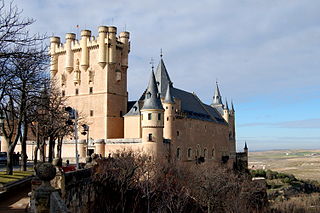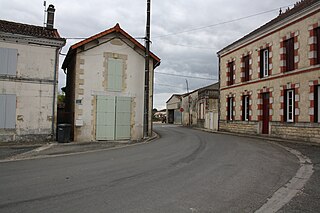Medieval castle
In the 12th century, a castle called the Château Saint-Vincent was raised on the spot of the present manor. Built in the faubourg of Agnou, within the fiefdom of the Boutigny family, it stood outside the long walls that enclosed Maule. The Boutignys owned the castle from the 13th century on: first Hugues de Boutigny, Lord of Gavral, then his son Jean de Boutigny. However, it was later dismantled by order of King Louis VI. In 1357, the city was pillaged by Charles II of Navarre, who totally leveled the edifice. From then on, the barons of Maule lived in town, in houses constructed for them. This situation would change in the 16th century.

A castle is a type of fortified structure built during the Middle Ages by predominantly the nobility or royalty and by military orders. Scholars debate the scope of the word castle, but usually consider it to be the private fortified residence of a lord or noble. This is distinct from a palace, which is not fortified; from a fortress, which was not always a residence for royalty or nobility; and from a fortified settlement, which was a public defence – though there are many similarities among these types of construction. Usage of the term has varied over time and has been applied to structures as diverse as hill forts and country houses. Over the approximately 900 years that castles were built, they took on a great many forms with many different features, although some, such as curtain walls and arrowslits, were commonplace.
Faubourg is an ancient French term approximating "suburb". The earliest form is Forsbourg, derived from Latin foris, 'out of', and Vulgar Latin burgum, 'town' or 'fortress'. Traditionally, this name was given to an agglomeration forming around a throughway leading outwards from a city gate, and usually took the name of the same thoroughfare within the city. As cities were often located atop hills, their outlying communities were frequently lower down. Many faubourgs were located below their towns, and the term "suburbs" is derived from this tendency.

A fief was the central element of feudalism and consisted of heritable property or rights granted by an overlord to a vassal who held it in fealty in return for a form of feudal allegiance and service, usually given by the personal ceremonies of homage and fealty. The fees were often lands or revenue-producing real property held in feudal land tenure: these are typically known as fiefs or fiefdoms. However, not only land but anything of value could be held in fee, including governmental office, rights of exploitation such as hunting or fishing, monopolies in trade, and tax farms.
Manor House
The barony of Maule was held by the Morainvillier family until 1597, [2] soon after which it would pass to the Harlays of Sancy, who had been acquiring local fiefdoms since 1578. The transfer occurred in 1602, when the title was obtained by Nicolas de Harlay, Lord of Sancy and Superintendent of Finances to King Henry IV.
Nicolas de Harlay, seigneur de Sancy (1546–1629) was a French soldier and diplomat.

The Superintendent of Finances was the name of the minister in charge of finances in France from 1561 to 1661. The position was abolished in 1661 with the downfall of Nicolas Fouquet, and a new position was created, the Controller-General of Finances.

Henry IV, also known by the epithet Good King Henry or Henry the Great, was King of Navarre from 1572 and King of France from 1589 to 1610. He was the first monarch of France from the House of Bourbon, a cadet branch of the Capetian dynasty. He was assassinated in 1610 by François Ravaillac, a fanatical Catholic, and was succeeded by his son Louis XIII.
Constructed in 1594, the Château d’Agnou was also called the Château du Hagnou or de Balagny. It owed its conception to Nicolas de Harlay, who wished to build a residence appropriate to his rank. It is likely that even Henry IV spent time there between hunting expeditions.
The marshes of the Bout d’Agnou area were drained in order to begin construction. Although the only actual result of the project was a single wing of the manor, measuring about 60 meters (200 feet), and a dovecote tower for keeping pigeons, the baron had much more ambitious plans. He wanted to build an immense quadrilateral structure flanked by four round towers.
A wing is part of a building - or any feature of a building - that is subordinate to the main, central structure. The individual wings may directly adjoin the main building or may be built separately and joined to it by a connecting structure such as a colonnade or pergola. New buildings may incorporate wings from the outset or these may be added at a later date as part of an expansion or remodelling.

A dovecote or dovecot or doocot is a structure intended to house pigeons or doves. Dovecotes may be free-standing structures in a variety of shapes, or built into the end of a house or barn. They generally contain pigeonholes for the birds to nest. Pigeons and doves were an important food source historically in Western Europe and were kept for their eggs, flesh, and dung.

In Euclidean plane geometry, a quadrilateral is a polygon with four edges and four vertices or corners. Sometimes, the term quadrangle is used, by analogy with triangle, and sometimes tetragon for consistency with pentagon (5-sided), hexagon (6-sided) and so on.
Through his marriage to Marie Moreau on February 15, 1575, Nicolas de Harlay acquired the land of Grosbois in 1596 and began the construction of another manor there in 1597, which could explain why he never completed the first one.

The château de Grosbois is a French castle in Boissy-Saint-Léger, Val-de-Marne.
The baron’s heirs were unable to retain ownership of the Château d’Agnou, which was sold in 1638 to Claude de Bullion, Superintendent of Finances and Keeper of the Seals of France.
Claude de Bullion was a French aristocrat and politician who served as a Minister of Finance under Louis XIII from 1632 to 1640. He was a close ally of Cardinal Richelieu.
Keeper of the Seals of France was an office of the French monarchy under the Ancien Régime. Its principal function was to supplement or assist the Chancellor of France. Its successor office under the Republic is the Keeper of the Seals, a title held by the Minister of Justice.
At the time of the French Revolution, the Château d’Agnou belonged to the Marquis de Boisse, who took the road to exile, leaving his manor to the vandalism of the revolutionaries. The ruins were sold in 1793 to Nicolas-François Fréret and finally recovered by the marquis in 1812.
In the 19th century, it belonged to the Maule Plainval family, and then to the Balagnys in 1876.
Used as a convalescent home during the First World War and occupied by the German Wehrmacht during the Second, it was left vacant through the 1960s. During the 1970s, it found new ownership and was gradually restored to its image of the 16th century. Today the property is under private co-ownership.
In 1979, it was used during the filming of Hugo Santiago’s Écoute voir... (See Here My Love) starring Catherine Deneuve.


























